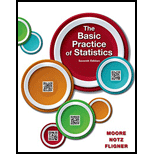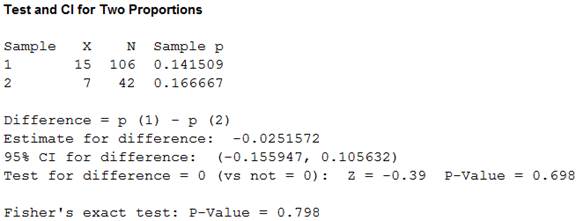
Concept explainers
(a)
To find: The proportions of failures for businesses headed by women and businesses headed by men.
To test: Whether the same proportion of women’s and men’s businesses fails or not.
To find: The hypotheses, the test statistic, P-value and conclusion.
(a)
Answer to Problem 23.25E
The proportion of failures for businesses headed by men is 0.1415.
The proportion of failures for businesses headed by women is 0.1666.
The null hypothesis is
The alternative hypothesis is
The value of the z-statistic is –0.39.
The P-value is 0.698.
The conclusion is that, the same proportion of women’s and men’s businesses fails.
Explanation of Solution
Given info:
In the survey, 15 out of 106 were headed by men failed and 7 out of 42 were headed by women failed.
Calculation:
PLAN:
Check whether the same proportion of women’s and men’s businesses fails or not.
State the test hypotheses.
Null hypothesis:
Alternative hypothesis:
SOLVE:
Test statistic and P-value:
Software procedure:
Step by step procedure to obtain proportion, test statistic and P-value using the MINITAB software:
- Choose Stat > Basic Statistics > 2 Proportions.
- Choose Summarized data.
- In First sample, enter Trials as 106 and
Events as 15. - In Second sample, enter Trials as 42 and Events as 7.
- Choose Options.
- Choose Pooled proportions.
- In Confidence level, enter 95.
- In Alternative, select not equal.
- Click OK in all the dialogue boxes.
Output using the MINITAB software is given below:

From the MINITAB output,
The proportion of failures for businesses headed by men is 0.1415.
The proportion of failures for businesses headed by women is 0.1666.
The value of the z-statistic is –0.39.
The P-value is 0.698.
CONCLUDE:
The P-value is 0.698 and the significance level is 0.05.
Here, the P-value is greater than the significance level.
That is,
Therefore, using the rejection rule, it can be concluded that there is no evidence to reject
Thus, the same proportion of women’s and men’s businesses fails.
(b)
To find: The proportions of failures for businesses headed by women and businesses headed by men.
To test: Whether the same proportion of women’s and men’s businesses fails or not.
To find: The hypotheses, the test statistic, P-value and conclusion.
(b)
Answer to Problem 23.25E
The proportion of failures for businesses headed by men is 0.1415.
The proportion of failures for businesses headed by women is 0.1666.
The null hypothesis is
The alternative hypothesis is
The value of the z-statistic is –2.12.
The P-value is 0.034.
The conclusion is that, there is no evidence that the same proportion of women’s and men’s businesses fails.
Explanation of Solution
Given info:
In the survey, 210 out of 1,260 were headed by women failed and 450 out of 3,180 were headed by men failed.
Calculation:
PLAN:
Check whether the same proportion of women’s and men’s businesses fails or not.
State the test hypotheses.
Null hypothesis:
Alternative hypothesis:
SOLVE:
Test statistic and P-value:
Software procedure:
Step by step procedure to obtain proportion, test statistic and P-value using the MINITAB software:
- Choose Stat > Basic Statistics > 2 Proportions.
- Choose Summarized data.
- In First sample, enter Trials as 3,180 and Events as 450.
- In Second sample, enter Trials as 1,260 and Events as 210.
- Choose Options.
- Choose Pooled proportions.
- In Confidence level, enter 95.
- In Alternative, select not equal.
- Click OK in all the dialogue boxes.
Output using the MINITAB software is given below:

From the MINITAB output,
The proportion of failures for businesses headed by men is 0.1415.
The proportion of failures for businesses headed by women is 0.1666.
The value of the z-statistic is –2.12.
The P-value is 0.034.
CONCLUDE:
The P-value is 0.034 and the significance level is 0.05.
Here, the P-value is less than the significance level.
That is,
Therefore, using the rejection rule, it can be concluded that there is evidence to reject
Thus, there is no evidence that the same proportion of women’s and men’s businesses fails.
(c)
To find: The 95% confidence interval for the difference between the proportions of women’s and men’s businesses that fail for the settings of part (a).
To find: The 95% confidence interval for the difference between the proportions of women’s and men’s businesses that fail for the settings of part (b).
To identify: The effect of larger samples on the confidence interval.
(c)
Answer to Problem 23.25E
The 95% confidence interval for the difference between the proportions of women’s and men’s businesses that fail for the settings of part (a) is
The 95% confidence interval for the difference between the proportions of women’s and men’s businesses that fail for the settings of part (b) is
The effect of larger samples on the confidence interval is that the confidence interval is narrow.
Explanation of Solution
Given info:
In the survey, 210 out of 1,260 were headed by women failed and 450 out of 3,180 were headed by men failed.
Calculation:
From part (a), the 95% confidence interval for the difference between the proportions of women’s and men’s businesses that fail for the settings of part (a) is
From part (b), the 95% confidence interval for the difference between the proportions of women’s and men’s businesses that fail for the settings of part (b) is
Justification:
From the results, it can be observed that the confidence interval is narrow if the sample is 30 times large.
Want to see more full solutions like this?
Chapter 23 Solutions
The Basic Practice of Statistics
- Harvard University California Institute of Technology Massachusetts Institute of Technology Stanford University Princeton University University of Cambridge University of Oxford University of California, Berkeley Imperial College London Yale University University of California, Los Angeles University of Chicago Johns Hopkins University Cornell University ETH Zurich University of Michigan University of Toronto Columbia University University of Pennsylvania Carnegie Mellon University University of Hong Kong University College London University of Washington Duke University Northwestern University University of Tokyo Georgia Institute of Technology Pohang University of Science and Technology University of California, Santa Barbara University of British Columbia University of North Carolina at Chapel Hill University of California, San Diego University of Illinois at Urbana-Champaign National University of Singapore McGill…arrow_forwardName Harvard University California Institute of Technology Massachusetts Institute of Technology Stanford University Princeton University University of Cambridge University of Oxford University of California, Berkeley Imperial College London Yale University University of California, Los Angeles University of Chicago Johns Hopkins University Cornell University ETH Zurich University of Michigan University of Toronto Columbia University University of Pennsylvania Carnegie Mellon University University of Hong Kong University College London University of Washington Duke University Northwestern University University of Tokyo Georgia Institute of Technology Pohang University of Science and Technology University of California, Santa Barbara University of British Columbia University of North Carolina at Chapel Hill University of California, San Diego University of Illinois at Urbana-Champaign National University of Singapore…arrow_forwardA company found that the daily sales revenue of its flagship product follows a normal distribution with a mean of $4500 and a standard deviation of $450. The company defines a "high-sales day" that is, any day with sales exceeding $4800. please provide a step by step on how to get the answers in excel Q: What percentage of days can the company expect to have "high-sales days" or sales greater than $4800? Q: What is the sales revenue threshold for the bottom 10% of days? (please note that 10% refers to the probability/area under bell curve towards the lower tail of bell curve) Provide answers in the yellow cellsarrow_forward
- Find the critical value for a left-tailed test using the F distribution with a 0.025, degrees of freedom in the numerator=12, and degrees of freedom in the denominator = 50. A portion of the table of critical values of the F-distribution is provided. Click the icon to view the partial table of critical values of the F-distribution. What is the critical value? (Round to two decimal places as needed.)arrow_forwardA retail store manager claims that the average daily sales of the store are $1,500. You aim to test whether the actual average daily sales differ significantly from this claimed value. You can provide your answer by inserting a text box and the answer must include: Null hypothesis, Alternative hypothesis, Show answer (output table/summary table), and Conclusion based on the P value. Showing the calculation is a must. If calculation is missing,so please provide a step by step on the answers Numerical answers in the yellow cellsarrow_forwardShow all workarrow_forward
 MATLAB: An Introduction with ApplicationsStatisticsISBN:9781119256830Author:Amos GilatPublisher:John Wiley & Sons Inc
MATLAB: An Introduction with ApplicationsStatisticsISBN:9781119256830Author:Amos GilatPublisher:John Wiley & Sons Inc Probability and Statistics for Engineering and th...StatisticsISBN:9781305251809Author:Jay L. DevorePublisher:Cengage Learning
Probability and Statistics for Engineering and th...StatisticsISBN:9781305251809Author:Jay L. DevorePublisher:Cengage Learning Statistics for The Behavioral Sciences (MindTap C...StatisticsISBN:9781305504912Author:Frederick J Gravetter, Larry B. WallnauPublisher:Cengage Learning
Statistics for The Behavioral Sciences (MindTap C...StatisticsISBN:9781305504912Author:Frederick J Gravetter, Larry B. WallnauPublisher:Cengage Learning Elementary Statistics: Picturing the World (7th E...StatisticsISBN:9780134683416Author:Ron Larson, Betsy FarberPublisher:PEARSON
Elementary Statistics: Picturing the World (7th E...StatisticsISBN:9780134683416Author:Ron Larson, Betsy FarberPublisher:PEARSON The Basic Practice of StatisticsStatisticsISBN:9781319042578Author:David S. Moore, William I. Notz, Michael A. FlignerPublisher:W. H. Freeman
The Basic Practice of StatisticsStatisticsISBN:9781319042578Author:David S. Moore, William I. Notz, Michael A. FlignerPublisher:W. H. Freeman Introduction to the Practice of StatisticsStatisticsISBN:9781319013387Author:David S. Moore, George P. McCabe, Bruce A. CraigPublisher:W. H. Freeman
Introduction to the Practice of StatisticsStatisticsISBN:9781319013387Author:David S. Moore, George P. McCabe, Bruce A. CraigPublisher:W. H. Freeman





